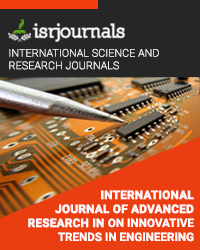pfc and speed control of bldc motor using zeta converter
C. Christo Shijith,S. Sujith
Published in International Journal of Advanced Research in Electrical and Electronics Engineering
ISSN: 2321-4775 Impact Factor:1.6 Volume:2 Issue:2 Year: 08 April,2014 Pages:52-58

Abstract
A Power Factor Correction (PFC) and sensorless speed control of BLDC (Brushless DC) motor using zeta converter is presented. Zeta converter is a fourth-order DC-DC converter made up of two inductors and two capacitors and capable of operating in either step-up or step-down mode. The PFC is achieved by zeta converter. Sensorless speed control of BLDC motor is achieved and the cost and wiring of sensors are reduced. A MATLAB/ Simulink environment is used to simulate the developed model to achieve a wide range of speed control with high PF (Power Factor) and improved PQ (Power Quality) at the supply.
Kewords
PFC, BLDC motor, zeta converter, sensorless speed control
Reference
[1] Bhim Singh, Vashist Bist, “A Single Sensor Based PFC Zeta Converter Fed BLDC Motor Drive for Fan Applications,” IEEE Trans.Ind. Appl., vol.31, no. 5, pp. Oct 2012. [2] B. Singh, B. N. Singh, A. Chandra, K. Al-Haddad, A. Pandey and D.P.Kothari, “A review of single-phase improved power quality AC-DC converters,” IEEE Transactions on Industrial Electronics, vol. 50, no.5, pp. 962– 981, Oct. 2003. [3] S. Singh and B. Singh, "Voltage controlled PFC Zeta converter based BLDC MOTOR drive for an air-conditioner," 2010 International Conference on Industrial and Information Systems (ICIIS), pp.550-555, 29th July 2010- 1st Aug. 2010. [4] D.C. Martins, “Zeta Converter Operating in Continuous Conduction Mode Using the Unity Power Factor Technique” in Proceedings of IEE PEVSD’96, 1996, pp.7-11. [5] Paul P. Acarnley and John F. Watson, “Review of Position-Sensorless Operation of Brushless Permanent-Magnet Machines”, IEEE Transactions on Industrial Electronics, Vol. 53, no. 2, April 2006. [6] Z.Chen, J.M Guerrero, and F.Blaabjerg, “comparisons between CCM Two - stage and single stage power factor correction converters,” IEEE Trans. Power electronics., Vol.24, No.8, pp1859-1875, Aug 2009. [7] James P. Johnson, M. Ehsani and Yilcan Guzelgunler, “Review of Sensorless Methods for Brushless DC” Industry Applications Conference, 34th IAS Annual Meeting, 1999, Vol. 1, pp. 143-150. [8] Ki-Bum Park, Chong-Eun Kim, Gun-Woo Moon, and Myung-Joong Youn, “ A double –ended Half-Bridge Zeta converter,” IEEE trans.On power electronics, vol.23, No.6, Nov 2008. [9] Pijit Kochcha, Sarawut Sujitjorn, “Isolated zeta converter: Principle of operation and design in continuous conduction mode,” WSEAS Trans. on CIRCUITS and SYSTEMS, Issue 7, Volume 9, July 2010. 7 [10] Dakshina Murthy-Bellur, “Isolated Two Transistor Zeta Converter with Reduced Transistor Voltage Stress,” IEEE trans. on circuits and systems-II, express briefs, vol. 58, no. 1, Jan 2011. [11] Jitty Abraham, K.Vasanth, “Desigh and simulation of Pulse-Width Modulated zeta converter with power factor correction,” International Journals, vol.2, No.2, pages: 232-238(2013). [12] Hao Zhang, Yuan Zhang, and Xikui Ma, “Distortion Behavior Analysis of General pulse-width Modulated Zeta PFC converter operating in continuous conduction mode,” IEEE trans. On power electronics, vol.27, No.10, Oct 2012. [13] Tae-Won chun, Quang-Vinh Tran, Hong-Hee Lee, and Heung-Geun Kim “sensorless control of BLDC motor Drive for an automotive fuel pump using a hysteresis comparator,” IEEE trans. On power electronics, vol.29, No.3, Mar 2014. [14] Alin stirban, Ion Boldea, and Gheorghe-Daniel Andreescu “Motion-sensorless control of BLDC-PM motor with offline FEM- Information-Assisted position and speed observer,” IEEE trans. On industry applications, Vol.48, No.6, Nov/Dec 2012.

